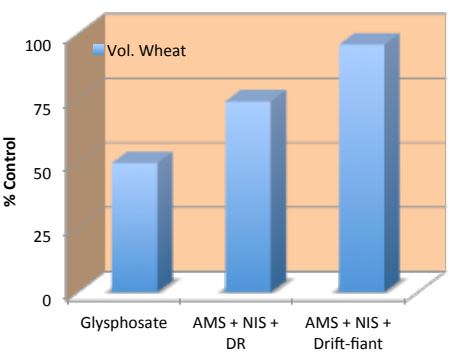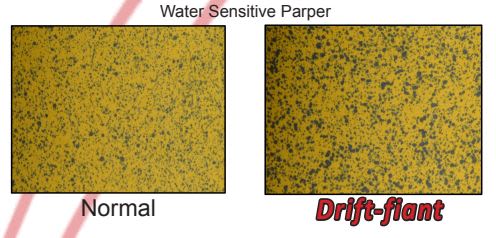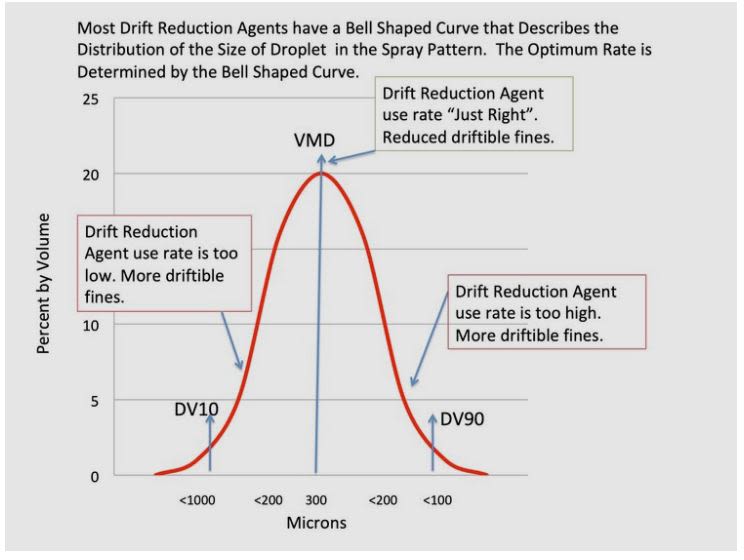Knowde Enhanced TDS
Identification & Functionality
- Agrochemical Functions
- Technologies
- Product Families
- Principal Functioning Agents
Phosphatidylcholine, modified seed oil, alkyl amine ethoxylate 999% Constituents Ineffective as Spray Adjuvants 1% Total 1000%
Features & Benefits
- Agrochemicals Features
- Additional Information
- Attention extreme care must be used when applying any pesticide to prevent injury to desirable plants and crops. A pesticide product may kill, seriously injure or reduce yields of many desirable forms of vegetation including flowers, fruits, grapes, tomatoes, ornamentals, vegetables, cotton, soybeans, tobacco, beans and other desirable non-target plants. Minute quantities of spray may cause severe plant response. Read and follow spray drift management section of the pesticide label. It is suggested to use a smoke generator or other means at or near the application site for the detection of air movement, air stability, or temperature inversions. An adjuvant or surfactant only may decrease, but not prevent, the likelihood of spray drift.
- Spray drift management a variety of factors including weather conditions (e.g., wind direction, wind speed, temperature, relative humidity) and method of application (.E.G., ground, aerial, airblast, chemigation) can influence pesticide drift. The applicator must evaluate all factors and make appropriate adjustments when applying this product.
- Droplet size when applying sprays that contain a pesticide as the sole active ingredient, or when applying sprays that contain that pesticide mixed with active ingredients that require a coarse or coarser spray, apply only as a coarse or coarser spray (ASAE standard 572) or a volume mean diameter of 385 microns or greater for spinning atomizer nozzles. When applying sprays that contain a pesticide mixed with other active ingredients that require a medium or more fine spray, apply only as a medium or coarser spray ASAE standard 572) or a volume mean diameter of 300 microns or greater for spinning atomizer nozzles.
- Wind speed do not apply at wind speeds greater than 10 mph, or the maximum permitted by state law. Only apply the pesticide product if the wind direction favors on-target deposition and there are not sensitive areas (including, but not limited to, residential areas, bodies of water, known habitat for nontarget species, nontarget crops) within 250 feet downwind. If applying a medium spray, leave one swath unsprayed at the downwind edge of the treated field.
- Temperature inversions if applying at wind speeds less than 3 mph (or the minimum permitted by state law), the applicator must determine if: a) conditions of temperature inversion exist, or b) stable atmospheric conditions exist at or below nozzle height. Do not make applications into areas of temperature inversions or stable atmospheric conditions.
- Susceptible plants do not apply under circumstances where spray drift may occur to food, forage, or other plantings that might be damaged or crops thereof rendered unfit for sale, use or consumption. Review the pesticide label for a list of susceptible crops. Small amounts of spray drift that might not be visible may injure susceptible plants.
- Other state and local requirements applicators must follow all state and local pesticide drift requirements regarding application of all pesticides. Where states have more stringent regulations, they must be observed.
- Equipment all aerial and ground application equipment must be properly maintained and calibrated using appropriate carriers or surrogates.
- Additional requirements for aerial applications the boom length must not exceed 75% of the wingspan or 90% of the rotor blade diameter. Release spray at the lowest height consistent with efficacy and flight safety. Do not release spray at a height greater than 10 feet above the crop canopy unless a greater height is required for aircraft safety. This requirement does not apply to forestry or rights-of-way applications. When applications are made with a crosswind, the swath will be displaced downwind. The applicator must compensate for this by adjusting the path of the aircraft upwind.
- Additional requirements for ground boom application: do not apply with a nozzle height greater than 4 feet above the crop canopy
Applications & Uses
- Markets
- Applicable Crop
- Application Technique
- Drift Reduction Testing
Drift-Faint is a tremendous general spray drift reduction agent. A favorite of many aerial applicators. Excellent at reducing fines and improving deposition.
1pt 100 gal Drift-fiant + Full load 3 pts/ 100 gal
- Directions For Use
USE THIS PRODUCT ONLY AS SPECIFIED ON LABEL.. DRIFT-FIANT™ should be added to the spray mixture after all other spray components have been added to the spray mixture. DRIFT-FIANT™ adjuvant can be used at rates of 1-2 pints per 100 gallons of spray mixture in most agricultural uses. Most applications with Aqueous Solution (AS), glyphosate, use rate 1-2 pints/100 gallons of spray solution. Dry Flowables (DF) and Wettable Powder (WP) Wettable Powder (WP) work well with 1 pt/100 gallons of spray solution. Emulsifiable Concentrate (EC) use rates can be increased to 2pts/100 gallons of spray solution. Most crops have shown excellent safety to this product. However, before treating a large area of a horticultural crop test a small area first for crop safety. DO NOT EXCEED A RATE OF 1% OF FINAL SPRAY VOLUME WITH THIS PRODUCT. NOT FOR AQUATIC USE.
Regulatory & Compliance
- Regulatory
All ingredients are exempt from tolerance requirements under 40 CFR 180.
Technical Details & Test Data
- Technical Data
Drift-fiant improves Deposition and Droplet Retention on the leaf increasing herbicide uptake and performance giving you better control

Control of Volunteer Wheat with Glyphosate Applied Alone and with Tank Additives. Drif Reduction agent+ AMS 17lbs/100 + NIS 1qts/100. Drif-fant+ AMS 17lbs/100 + NIS 1qts/100
- Canopy Penetration
Drift-fiant increases the amount of bigger droplets that penetrate the canopy and provide better plant coverage

- Drift Reduction
Drift-fiant reduces the number of driftable fnes by increasing water elasticity therefore creating bigger droplets
Nozzle
TypePSI Mean
Diameter
DVM
MicronsPercent
Increase
in DVM
with
Drift-FiantPercent
Driftable
FinesPercent
Decreas
e of
Driftable
Fine with
Drift-Fiant%
Larger
than 700
Microns
(Too Big)% Larger
than 600
Microns
with
Drift-FiantXR11001 20 220 30% 0.33 40% 0 0% 40 114 11% 0.7 11% 0.01 0% XR11003 20 204 27% 0.17 74% 0 0% 40 168 20% 0.43 35% 0 0% TT1101 20 414 1% 0.08 7% 0.07 50% 40 298 1% 0.19 10% 0.016 0% TF 2.5 20 0.035 40 370 NA 0.065 NA 0 NA AIRX110
0120 515 5% 0.075 50% 0.16 10% 40 404 7% 0.15 45% 0.04 0.50% - Compatibility:Drift-fiant works with all agricultural sprays.
- Low Use Rates: 1-2 pints/100 Aerial applications 1 pint/100
- Effcacy: Drift-fiant out performs the industry standard and at lower use rates
- Understanding Drift Reduction Jargon
DRIFT REDUCTION BASICS
Drift Reduction or better described, as spray droplet size increase is dependent upon changing the physics of the spray solution without increasing the surface tension of the water droplet. This interaction will in a large degree determine the use rate of the drift reduction adjuvant including Drift-fiant. Too little Drift Reduction Agent and it does not work. Too much and it will increase fines.

Safety & Health
- Safety
- HAZARD STATEMENT: HARMFUL IF SWALLOWED. MAY CAUSE AN ALLERGIC SKIN REACTION. CAUSES SERIOUS EYE IRRITATION. MAY CAUSE RESPIRATORY IRRITATION. VERY TOXIC TO AQUATIC LIFE. Have the product container label with you when calling a poison control center or doctor, or going for treatment. You may also contact 1-800-222-1222 for emergency medical tratment information.
- PRECAUTIONARY STATEMENT Avoid breathing mist/ vapors/ spray. Wash thoroughly with soap and water after handling. Do not eat, drink or smoke after using this product. Use only outdoors or in a well-ventilated area. Take off contaminated clothing and wash it before reuse. Specific treatment see First Aid section on this label or Safety Data Sheet. Store locked up. Dispose of contents/ container according to instructions in the Storage and Disposal section on the label.
- PERSONAL PROTECTIVE EQUIPMENT Wear protective gloves / protective clothing / eye protection/face protection.
- ENVIRONMENTAL HAZARDS Do not contaminate water by cleaning of equipment or disposal of wastes. Use this product only as specified on label.
- PHYSICAL OR CHEMICAL HAZARDS Wash LOAD OUT-CA spillage off thoroughly. The same precautions should be observed in equipment stored after use. If LOAD OUT-CA concentrate contacts clothing, flush with water
First Aid
- IF SWALLOWED Wash out mouth thoroughly with water. Get medical attention. Contact a Poison Control Center. Do not induce vomiting
- IF ON SKIN Skin Immediately flush with plenty of water while removing contaminated clothing. As soon as soap is available, wash thoroughly with soap and water. Wash clothing before reuse.
- IF INHALED None normally needed. Remove to fresh air if breathing is difficult. Give oxygen and call a physician.
- IF IN EYES Immediately flush with plenty of water for at least 15 minutes. Get medical attention.
Storage & Handling
- Storage
DO NOT CONTAMINATE WATER, FOOD OR FEED BY STORAGE OR DISPOSAL. Do not store at temperatures above 140°F. DISPOSAL: Wastes resulting from the use of this product may be disposed of on site or at an approved waste disposal facility. CONTAINER DISPOSAL: Triple rinse (or equivalent) during mixing and loading. Recycling decontaminated containers is the best option of container disposal. The Agricultural Container Recycling Council (ACRC) operates the national recycling program. To contact your state and local ACRC recycler visit the ACRC web page at www.acrecyle.org. Decontaminated containers may also be disposed of in a sanitary landfill.

